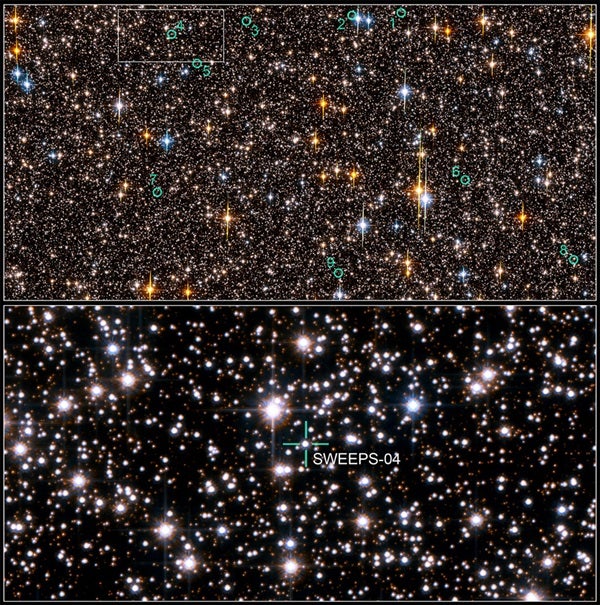Scientists pointed the Hubble Space Telescope (HST) toward the Milky Way’s crowded central bulge nearly 26,000 light-years away. Hubble looked farther into our galaxy than ever before and revealed 16 extrasolar-planet candidates among nearly 180,000 stars.
From February 23–29, 2004, a survey known as the Sagittarius Window Eclipsing Extrasolar Planet Search (SWEEPS) scanned the sky using Hubble’s Advanced Camera for Surveys. The observed region was no larger in angular size than 2 percent of the Full Moon. The team searched for exoplanets by measuring the slight dimming of a star due to a transiting planet. The exoplanet had to be at least the size of Jupiter to block enough starlight — about 1 to 10 percent — for HST to detect it. This survey could more than double the number of extrasolar planets discovered using the transit technique.
“Discovering the very-short-period planets was a big surprise,” says team leader Kailash Sahu of the Space Telescope Science Institute in Baltimore. “Only the Hubble Space Telescope, with its superb resolution and sensitivity, can look across our galaxy and find planets around faint stars. Our discovery also gives very strong evidence that planets are as abundant in other parts of the galaxy as they are in our solar neighborhood.”
Five of these exoplanets are of a new breed: Ultra-Short-Period Planets (USPPs). These exotic bodies orbit their stars in less than a day. “USPPs occur preferentially around normal red dwarf stars that are smaller and cooler than our Sun,” explains Sahu. The shortest of these orbits, about 10 hours, was found for an exoplanet called SWEEPS-10.
SWEEPS-10, located about 745,000 miles (1.2 million kilometers) away from its home star, also is one of the hottest known exoplanets at a scorching 3,000° Fahrenheit (1,650° Celsius). Sahu believes the planet has to be at least 1.6 times Jupiter’s mass to survive the star’s gravitational pull.
The results will appear in the October 5 Nature.










